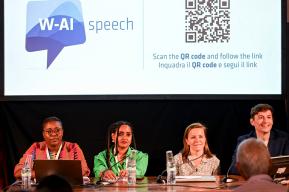News
New UNESCO resources for journalism education launched in Lyon, France

Dealing with the coverage of Artificial Intelligence (AI), and with teaching journalism online, the two publications are the fruit of a partnership between UNESCO and the World Journalism Education Council (WJEC). The relationship has also resulted in more than 17 webinars organised by WJEC affiliates across 16 countries.
The two new books stimulated a vibrant panel discussion titled “Teaching journalism today”, at the start of the IAMCR congress in Lyon.
The publications were made possible with financial support to WJEC from UNESCO’s International Programme for the Development of Communication (IPDC).
Currently available in English, new backing from Code4Africa will shortly see them available in Kiswahili, while support from Oman will enable Arabic translations.
During the launch session at IAMCR, a summary of the handbook “Reporting Artificial Intelligence” was presented. It provides explanations of AI, machine learning, algorithms and other technical terms, as well assessment of how cultural contexts affect the framing of AI. Also in the book are practical tips for finding and telling stories about AI. The respondent was Prof Barbie Zelizer, founder of the Center for Media at Risk at the University of Pennsylvania.
She said she had “learned a lot from this report”. The professor said scepticism was needed to ensure that the topic of AI responded to journalists, their occupational standards and practices, rather than the other way around.
It is important that coverage of AI does not exclude parts of newsmaking that are not technologically driven – [such as] curiosity, drive, independence, intuition, the unexpected. Neither should coverage lead to prioritising speed, patterning, formulaic and template-based writing, structured information, [and] routinized events.
Prof Zelizer further cautioned that the notion of “AI’s inevitability”, which she said is “the idea that’s it’s already everywhere and we all need to get on board,” could diminish journalism’s horizon.
Introducing the second IPDC handbook “Teaching journalism online”, was its co-editor Prof Susan Keith of Rutgers University. She noted that this resource had contributions by 19 authors from nine countries.
It had not been easy to find these writers, since journalism teachers are mainly known for what they teach, not how they teach. It was therefore difficult to identify who actually had top experience in online pedagogy, she remarked.
Teaching online — at least teaching online well — takes more effort than teaching in person. The content of a face-to-face class can’t merely be shovelled online with any expectation that the effort will be successful.
She outlined how the handbook, drawing on the experience of the pandemic, offered practical advice to journalism teachers. The topics include tips on planning and transitioning to online courses, how to deal with plagiarism in online education, and supporting diversity in virtual classrooms.
Prof Keith added: “Being ready to teach journalism online prepares us for the next health crisis, civil crisis or other unforeseen event that forces students to learn virtually.” Meantime, many courses are using blended learning, with online and in person exchanges.
Responding to the handbook, Prof Viola Milton of the University of South Africa, a distance-learning institution, said the publication has a welcome balance between pedagogical considerations and course content considerations in Learning Management Systems.
Noting a gap, she pointed out that “a chapter dealing with student experiences in diverse settings would be most useful (also for ensuring that our pedagogical assumptions meet student circumstances and needs).”
The professor has agreed to lead a panel on the two handbooks at the upcoming conference of the South Africa Communications Association. Other events are planned in diverse gatherings with journalism educators elsewhere.
The IAMCR session also included WJEC vice president Dr Nico Drok, who presented the results of a survey of 1696 journalism teachers from 46 countries. Dr Beate Josephi compared the findings to the Worlds of Journalism survey which gathers views from journalists. Prof Trevor Cullen contributed experiences of journalism educators engaging with editors. He also announced that the next congress of the WJEC will be held in Perth, Australia.
The two handbooks launched at the IAMCR are part of UNESCO/IPDC’s Journalism Education series, which includes a range of freely accessible, model curricula and specialized handbooks for journalist educators.







